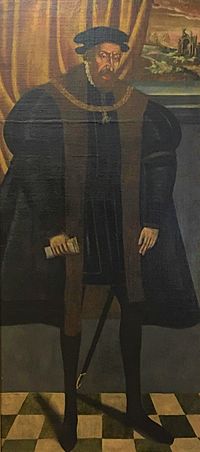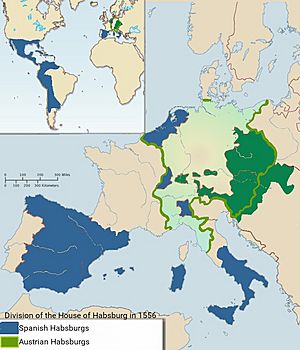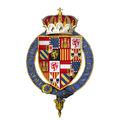Ferdinand I, Holy Roman Emperor facts for kids
Quick facts for kids Ferdinand I |
|
|---|---|
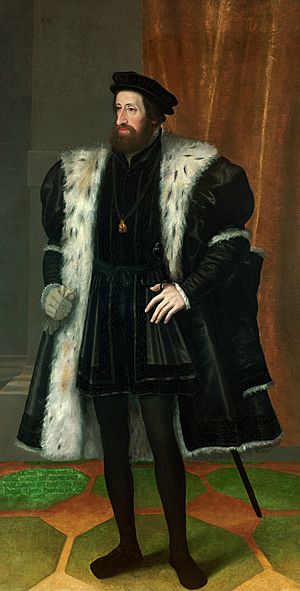
Portrait by Hans Bocksberger der Ältere
|
|
| Holy Roman Emperor | |
| Reign | 27 August 1556 – 25 July 1564 |
| Proclamation | 14 March 1558, Frankfurt |
| Predecessor | Charles V |
| Successor | Maximilian II |
| King of the Romans King in Germany |
|
| Reign | 5 January 1531 – 25 July 1564 |
| Predecessor | Charles V |
| Successor | Maximilian II |
| King of Hungary, Croatia, and Bohemia | |
| Reign | 1526 – 25 July 1564 |
| Coronation | 3 November 1527 (Hungary) 24 February 1526 (Bohemia) |
| Predecessor | Louis II |
| Successor | Maximilian II |
| Archduke of Austria | |
| Reign | 21 April 1521 – 25 July 1564 |
| Predecessor | Charles I |
| Successor | Maximilian II (Austria proper) Charles II (Inner Austria) Ferdinand II (Further Austria) |
| Born | 10 March 1503 Alcalá de Henares, Castile, Spain |
| Died | 25 July 1564 (aged 61) Vienna, Austria |
| Burial | Prague, St. Vitus Cathedral, Czech Republic |
| Spouse | |
| Issue see detail... |
|
| House | Habsburg |
| Father | Philip I of Castile |
| Mother | Joanna of Castile |
| Religion | Roman Catholicism |
| Signature | |
Ferdinand I (born March 10, 1503 – died July 25, 1564) was a very important ruler in Europe. He became the Holy Roman Emperor in 1556. Before that, he was the King of Bohemia, Hungary, and Croatia starting in 1526. He was also the Archduke of Austria from 1521 until his death.
Ferdinand was the younger brother of Charles V, Holy Roman Emperor, who was a powerful emperor. Ferdinand often helped his brother rule the Holy Roman Empire. He was good at making friends with German princes and even worked with important banks like the Fugger family.
During his time as ruler, Ferdinand faced two big challenges: the powerful Ottoman Empire trying to expand into Europe, and the Protestant Reformation, which caused many religious wars. Ferdinand wasn't a military general, but he was a smart organizer. He wanted to create a strong, central government for Austria, Hungary, and Bohemia. He brought back some ideas from his grandfather, Maximilian I, Holy Roman Emperor, like the Hofrat (court council). He also created new groups like the War Council to fight the Ottomans. Ferdinand was known for being flexible and tolerant, especially when it came to religion. His motto was: "Let justice be done, though the world perish." This means he believed in doing what was right, no matter the cost.
Contents
Biography
Early Life and Education
Ferdinand was born in 1503 in Alcalá de Henares, a city in Spain. His parents were Philip I of Castile and Joanna of Castile. He had the same name and birthday as his grandfather, Ferdinand II of Aragon. Ferdinand grew up and went to school in Spain. He didn't learn German until he was an adult.
In 1518, Ferdinand traveled to Flanders. His older brother, Charles V, had just become King Charles I of Spain. In 1519, their grandfather Maximilian I died. Charles V then became the Holy Roman Emperor. Charles gave Ferdinand control over the Austrian lands, which are now parts of Austria and Slovenia. Ferdinand became the Archduke of Austria in 1521. Even though he supported his brother, Ferdinand worked hard to make his own lands stronger. He learned German and became closer to the German princes.
Becoming King and Emperor
In 1526, Ferdinand's brother-in-law, Louis II of Hungary, died in battle. This meant Ferdinand became the King of Bohemia and Hungary. He also often acted as his brother Charles's helper in the Holy Roman Empire. In 1531, German princes elected Ferdinand as the King of the Romans. This meant he was chosen to be Charles's successor as emperor.
In 1556, Charles V decided to give up his power. He gave the Spanish Empire (including Spain, the Netherlands, and lands in the Americas) to his son, Philip. Ferdinand then became the Holy Roman Emperor. He officially took the title in 1558.
Challenges and Conflicts
Fighting the Ottoman Empire
In 1515, Ferdinand married Anne of Bohemia and Hungary. She was the daughter of King Vladislaus II of Bohemia and Hungary. After her brother, Louis II, died in 1526, Ferdinand wanted to become King of Hungary and Bohemia. The people of Bohemia chose him as their king in October 1526. They wanted him to respect their old traditions.
However, the throne of Hungary was also wanted by John Zápolya, a Hungarian noble. Hungarian nobles were divided, some supporting Ferdinand, others Zápolya. Ferdinand was elected King of Hungary by some nobles in December 1526 and was crowned in 1527. The Croatian nobles also accepted Ferdinand as their king in 1527. Ferdinand promised to protect Croatia from the Ottoman Empire.
Ferdinand's brother, Charles V, was busy fighting wars in other parts of Europe. So, Ferdinand was largely responsible for defending Central Europe from the Ottomans. He had to introduce a special "Turkish Tax" to pay for the defense, but it was often not enough. He also borrowed money from rich bankers like the Fugger family.
Ferdinand fought against John Zápolya and defeated him in 1527 and 1528. Zápolya then asked the Ottoman Sultan, Suleiman the Magnificent, for help. This made Hungary an Ottoman vassal state, meaning it was under Ottoman control.
In 1529, Suleiman led a huge attack on Ferdinand's capital, Vienna. This was a very dangerous time for Ferdinand, and he had to flee to Bohemia. The Ottomans failed to capture Vienna. Another Ottoman invasion was stopped in 1532. Ferdinand then made peace with the Ottomans in 1533. Hungary was split into a western part controlled by Ferdinand and an eastern part controlled by John Zápolya, which was under Ottoman influence.
In 1538, Zápolya agreed that Ferdinand would be his successor since Zápolya had no children. But in 1540, just before he died, Zápolya had a son, John Sigismund Zápolya. This son was quickly made king by the Hungarian nobles. Ferdinand invaded Hungary, but the Ottomans stepped in to protect John Sigismund. Suleiman took control of central Hungary and forced Ferdinand to pay tribute for his lands in western Hungary.
The war in Hungary continued for many years. Ferdinand tried to get Transylvania back, but it remained under Ottoman influence for a long time. The wars with the Ottomans were very costly for the Habsburgs. Even though Hungary was badly damaged by war, it was still a very important source of income for Ferdinand.
Dealing with Religious Changes in Bohemia
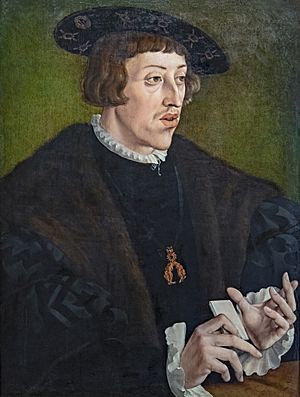
When Ferdinand took control of Bohemia in the 1520s, there were many different religions. Some people were Catholic, others were Lutherans, and many Czechs followed Hussite beliefs. At first, Ferdinand allowed a lot of religious freedom.
However, in the 1540s, things changed. Protestant princes in Germany started to challenge the Emperor. Many people in Bohemia, both German and Czech, supported these Protestants. In 1547, Ferdinand and his brother Charles V won a war against the German Protestants. In the same year, Ferdinand also put down a Protestant revolt in Bohemia. This allowed him to gain more power there. He took away some city privileges and brought in new royal officials to control local authorities. Ferdinand also wanted to make the Catholic Church stronger in Bohemia. He invited the Jesuits, a Catholic religious order, to Bohemia.
The Peace of Augsburg (1555)
In the 1550s, Ferdinand became very important in solving religious problems in the Holy Roman Empire. He was more popular than his brother Charles V among Protestant princes.
After many years of religious fighting, Charles V called a big meeting in Augsburg. Charles didn't go himself; he let Ferdinand handle it. At this meeting, which started in February 1555, Ferdinand worked hard to get everyone to agree. On September 25, they agreed on three main ideas:
- "Whose realm, his religion" (cuius regio, eius religio): This meant that the ruler of a state would decide the religion for everyone in that state. If people didn't want to follow the ruler's religion, they were allowed to move somewhere else. This was a new idea at the time.
- Church property rule (reservatum ecclesiasticum): If a church leader in a church-owned state changed his religion, the people in that state didn't have to change theirs. Instead, the church leader was expected to leave his position.
- Ferdinand's Declaration (Declaratio Ferdinandei): Ferdinand added this rule at the last minute. It allowed knights and some cities to keep their religious freedom if they had been practicing the reformed religion since the 1520s. This created some mixed cities where Catholics and Lutherans lived together.
These agreements helped calm many tensions between Catholics and Lutherans. However, they didn't include other Protestant groups like the Anabaptists or followers of John Calvin. These groups were still seen as heretics.
Charles V Steps Down
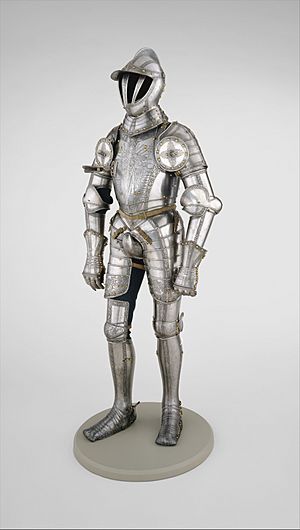
In 1556, Charles V officially gave up his power. He gave his Spanish lands to his son, Philip. Ferdinand became the Holy Roman Emperor. This had been planned since 1531 when Ferdinand was elected King of the Romans.
Ferdinand was a good choice because he understood the German princes and had been managing his brother's affairs in the Empire for years. Some historians believe Ferdinand was open to new religious ideas, but he remained Catholic throughout his life.
Charles's decision to split his empire had big effects. Philip's strict rule in the Netherlands led to a rebellion soon after he became king.
Holy Roman Emperor (1556–1564)
Ferdinand officially became Holy Roman Emperor in August 1556. The Imperial Diet (a kind of parliament) accepted his title in 1558. The Pope also recognized him as Emperor in 1559. During his time as Emperor, the Council of Trent, an important meeting of the Catholic Church, came to an end. Ferdinand also made sure his son, Maximilian II, would succeed him by organizing an election in 1562.
Governing the Empire
Ferdinand created important new government groups. One was the Hofkriegsrat (Aulic War Council), set up in 1556 to manage military matters across all Habsburg lands. He also combined the Imperial and Austrian Chancelleries in 1559 to handle both imperial and Habsburg affairs. These groups formed the core of the Habsburg government in Vienna.
Unlike some earlier emperors, Ferdinand I didn't travel much. In 1533, he moved his main home to Vienna and stayed there most of the time. After the Ottoman siege in 1529, he worked hard to make Vienna a very strong fortress. After he became Emperor in 1558, Vienna became the official capital of the Holy Roman Empire.
Ruling Hungary, Bohemia, and Croatia
Ferdinand wanted to centralize power in his lands, like many other rulers at the time. In 1527, he created new government structures for Hungary, Bohemia, and Silesia. He made the governments more uniform and gained more control over money in Bohemia, which provided half of his income. However, the governments of these different lands mostly remained separate.
In 1547, the nobles of Bohemia rebelled against Ferdinand because he ordered their army to fight against German Protestants. After he stopped the revolt, he punished the Bohemian cities by taking away some of their special rights. He also put new royal officials in charge of city governments.
Ferdinand strongly supported the Counter-Reformation, which was the Catholic Church's response to Protestantism. In 1551, he invited the Jesuits to Vienna and later to Prague. In 1561, he brought back the Archdiocese of Prague, which had been closed due to the rise of Protestants.
After the Ottomans took over the traditional Hungarian coronation city, Székesfehérvár, the Hungarian Diet (parliament) decided in 1536 that Pressburg would be the new place for coronations and meetings. Ferdinand wanted the Hungarian and Bohemian parliaments to meet with the Austrian nobles, but everyone refused.
Even though the Habsburgs almost always became kings of Hungary after Ferdinand, the monarchy officially remained elective until 1627. Ferdinand also worked to make the connection between Bohemia and the Empire looser, so Bohemia didn't have to pay taxes to the Empire. This helped him keep Bohemia and other territories like Silesia and Moravia in a special position, similar to Austria.
Death and Succession
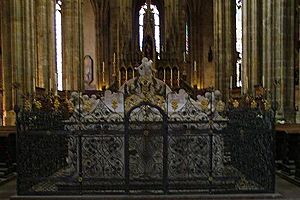
In December 1562, Ferdinand had his oldest son, Maximilian, elected King of the Romans. Maximilian then became King of Bohemia and, in 1563, King of Hungary.
Ferdinand died in Vienna in 1564. He is buried in St. Vitus Cathedral in Prague. After his death, Maximilian became emperor without any challenges.
Legacy
Ferdinand's rule had a lasting impact. Even with limited money and help from his brother, he managed to defend his lands against the Ottomans. He also secured a part of Hungary that would later help the Habsburgs take control of the whole kingdom. He created a tax system that his successors continued to use.
His way of dealing with the Protestant Reformation was more flexible and successful than his brother's. He played a key role in the 1555 Peace of Augsburg, which brought a period of peace to Germany. Overall, he was a careful and effective leader. However, when he tried more daring military actions, like attacking Buda, they often failed.
Historians say Ferdinand wasn't a great military commander, but he was a very creative and energetic administrator. He built a government system that lasted for centuries. This system included a court council, a private council, a central treasury, and a military affairs group.
Ferdinand also supported the arts. He made Vienna and Prague more beautiful. He reorganized the University of Vienna and invited Jesuits, architects, and scholars to his court. He was interested in music and hunting. He was the last King of Germany to be crowned in Aachen.
Marriage and Children
On May 26, 1521, in Linz, Austria, Ferdinand married Anna of Bohemia and Hungary (1503–1547). She was the daughter of Vladislaus II of Bohemia and Hungary. They had fifteen children together. Most of them lived to be adults:
| Name | Birth | Death | Notes |
|---|---|---|---|
| Elizabeth | 9 July 1526 | 15 June 1545 | Married to the future King Sigismund II Augustus of Poland. |
| Maximilian II, Holy Roman Emperor | 31 July 1527 | 12 October 1576 | Married to his cousin Maria of Spain and had children. |
| Anna | 7 July 1528 | 16/17 October 1590 | Married to Albert V, Duke of Bavaria. |
| Ferdinand II, Archduke of Austria | 14 June 1529 | 24 January 1595 | Married to Philippine Welser and then to his niece Anne Juliana Gonzaga. |
| Maria | 15 May 1531 | 11 December 1581 | Married to Wilhelm, Duke of Jülich-Cleves-Berg. |
| Magdalena | 14 August 1532 | 10 September 1590 | Became a nun. |
| Catherine | 15 September 1533 | 28 February 1572 | Married to Duke Francesco III of Mantua and then to King Sigismund II Augustus of Poland. |
| Eleanor | 2 November 1534 | 5 August 1594 | Married to William I, Duke of Mantua. |
| Margaret | 16 February 1536 | 12 March 1567 | Became a nun. |
| John | 10 April 1538 | 20 March 1539 | Died as a baby. |
| Barbara | 30 April 1539 | 19 September 1572 | Married to Alfonso II, Duke of Ferrara and Modena. |
| Charles II, Archduke of Austria | 3 June 1540 | 10 July 1590 | Was the father of Ferdinand II, Holy Roman Emperor. |
| Ursula | 24 July 1541 | 30 April 1543 | Died as a young child. |
| Helena | 7 January 1543 | 5 March 1574 | Became a nun. |
| Joanna | 24 January 1547 | 10 April 1578 | Married to Francesco I de' Medici, Grand Duke of Tuscany. |
Images for kids
See also
 In Spanish: Fernando I del Sacro Imperio Romano Germánico para niños
In Spanish: Fernando I del Sacro Imperio Romano Germánico para niños
- Parade armor of Ferdinand I
- Kings of Germany family tree
- First Congress of Vienna in 1515
- Battle of Mohács in 1526
- Louis II of Hungary
- John Zápolya, disputed king of Hungary 1526–40
- Ivan Karlović, Banus of Croatia 1521–24 and 1527–31
- Petar Keglević, Banus of Croatia 1537–42
- Pavle Bakic, last Despot of Serbia to be recognised by Ferdinand I and Holy Roman Empire in 1537
- Jovan Nenad, self-proclaimed Emperor of Vojvodina
- Balthasar Hubmaier, Anabaptist theologian, executed by burning




